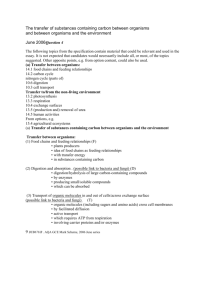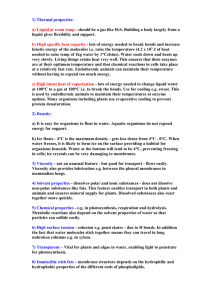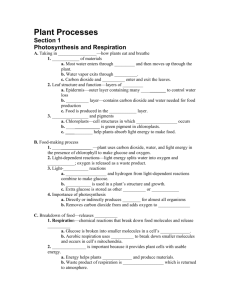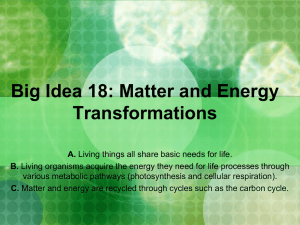NAME KS3 revision booklet Biology
advertisement
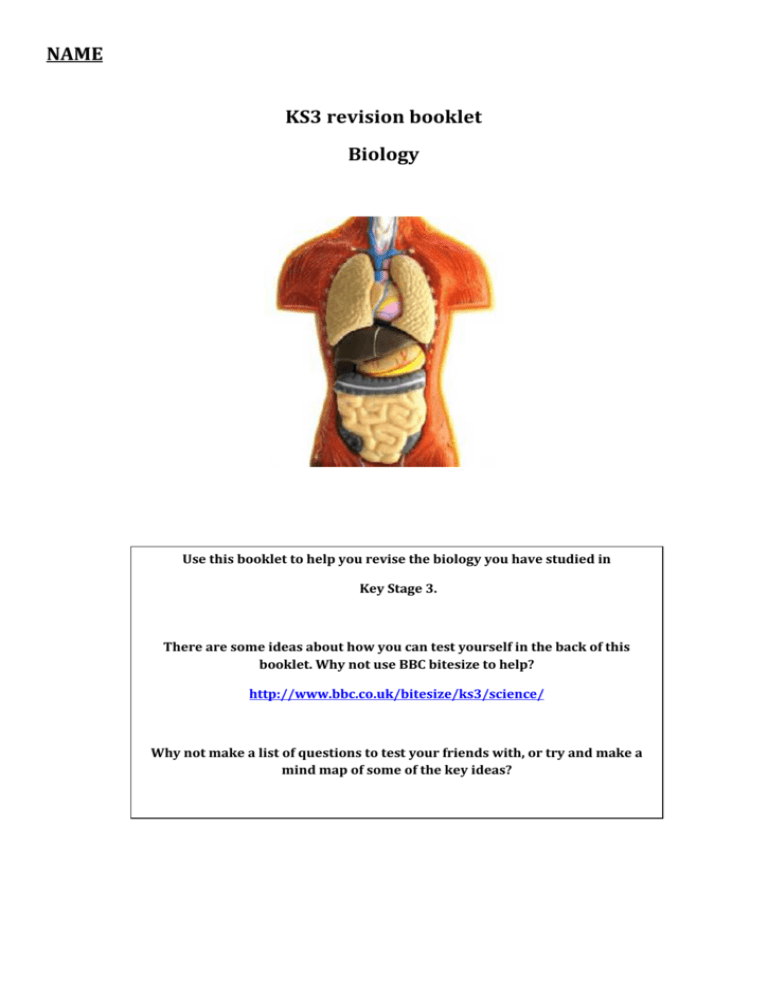
NAME KS3 revision booklet Biology Use this booklet to help you revise the biology you have studied in Key Stage 3. There are some ideas about how you can test yourself in the back of this booklet. Why not use BBC bitesize to help? http://www.bbc.co.uk/bitesize/ks3/science/ Why not make a list of questions to test your friends with, or try and make a mind map of some of the key ideas? Remember- a little and often is the best way to revise! Animal cells and plant cells Animal cells usually have an irregular shape, and plant cells usually have a regular shape Cells are made up of different parts. It is easier to explain what these parts are by using diagrams like the ones below. Animal cells and plant cells both contain: cell membrane, cytoplasm, nucleus Plant cells also contain these parts, not found in animal cells: chloroplasts, vacuole, cell wall The table summarises the functions of these parts. Part Function Found in Cell membrane Controls what substances can get into and out of the cell. Plant and animal cells Nucleus Controls what happens inside the cell. Carries genetic information. In exams don't call the nucleus the 'brain' of the cell. That is not a good description and will not get you marks. Plant and animal cells Cytoplasm Chloroplast Vacuole Cell wall Jelly-like substance, where chemical reactions happen. In plant cells there's a thin lining, whereas in animal cells most of the cell is cytoplasm. Where photosynthesis happens – chloroplasts contain a green substance called chlorophyll. Contains a liquid called cell sap, which keeps the cell firm. Made of a tough substance called cellulose, which supports the cell. Plant and animal cells Plant cells only Plant cells only Plant cells only Cells and their functions Humans are multi-cellular animals. That means we are made of lots of cells, not just one cell. The cells in many multicellular animals and plants are specialised, so that they can share out the processes of life. They work together like a team to support the different processes in an organism. Specialised cells You should be able to work out special features of a cell from a drawing, if you are told what the cell can do. The tables below show examples of some specialised animal and plant cells, with their functions and special features. Type of animal cell Function Special features Red blood cells To carry oxygen Nerve cells To carry nerve impulses to different parts of the body Long Connections at each end Can carry electrical signals Female reproductive cell (egg cell) To join with male cell, and then to provide food for the new cell that's been formed Large Contains lots of cytoplasm Male reproductive cell (sperm cell) To reach female cell, and join with it Long tail for swimming Head for getting into the female cell Large surface area, for oxygen to pass through Contains haemoglobin, which joins with oxygen Type of plant cell Function Special features Root hair cell To absorb water and minerals Large surface area Leaf cell To absorb sunlight for photosynthesis Large surface area Lots of chloroplasts MRS GREN Living things have certain life processes in common. There are seven things that they need to do to count as being alive. The phrase MRS GREN is a way to remember them: M Movement All living things move, even plants S Sensitivity Detecting changes in the surroundings R G R E N Respiration Growth Reproduction Excretion Nutrition Getting energy from food All living things grow Making more living things of the same type Getting rid of waste Taking in and using food It can be easy to tell if something is living or not. A teddy bear might look like a bear, but it can't do any of the seven things it needs to be able to do to count as being alive. What about a car? A car can move, it gets energy from petrol (like nutrition), it might have a car alarm (sensitivity), and it gets rid of waste gases through its exhaust pipe (excretion). But it can't grow or make baby cars. So a car is not alive. Respiration All living cells need to respire to release energy. Energy is needed by organisms to help them move, grow and make new substances to help them stay alive. Respiration normally requires oxygen and so it is called aerobic (with air) respiration. It is a series of chemical reactions which can be summarised in a word equation: glucose + oxygen carbon dioxide + water (+ energy) Glucose and oxygen are the reactants. Carbon dioxide and water are the products. Energy is released but it is not a chemical substance so we can either miss it out of the equation or put it in brackets. Glucose is supplied by the digestion of carbohydrates. It is carried around the body dissolved in the plasma of the blood. The blood travels through blood vessels and is pumped by the heart. The heart and the blood vessels form the circulatory system. The oxygen is absorbed from the air by the lungs. The lungs are part of the breathing system. The alveoli give the lungs a large surface area so that oxygen can quickly diffuse from the air inside the lungs into the blood contained in capillaries. The walls of the alveoli and the walls of the capillaries are only one cell thick which also makes it easy for oxygen to diffuse into the blood. The oxygen is carried by the red blood cells. Fit and healthy Being fit means that your body can cope with the activities that you need to do. To stay fit you should eat a balanced diet, exercise regularly, avoid smoking and avoid alcohol and drug abuse. If you follow these rules your heart will stay healthy and you will be less likely to suffer from high blood pressure and other circulatory problems like heart disease (when heart muscle cells start to die). Drugs are chemicals that affect how the body works. Cigarettes contain a drug called nicotine which is addictive (you feel that you cannot do without it). The chemicals in cigarette smoke can cause diseases. Poison in cigarette smoke nicotine tar carbon monoxide Harm it causes Makes arteries narrower, causes heart disease. Clogs up the lungs and stops the cilia working, causes cancer and bronchitis. Stops red blood cells carrying so much oxygen. Medicines are drugs that can help people who are suffering from diseases, e.g. antibiotics. Recreational drugs are legal drugs that people take because they like the effect that they have on their body, e.g. caffeine in coffee and alcohol. Illegal drugs include heroin and Ecstasy. Drugs that slow down the nervous system are called depressants. Alcohol is a depressant. It alters behaviour and slows reaction time. Drugs that speed up the nervous system are called stimulants, e.g. caffeine. Misuse of any drug can be harmful especially to the liver. Food and digestion We need to eat a wide variety of foods to provide our bodies with all the substances that are needed. When we do this, we are said to have a balanced diet. Substance needed carbohydrate protein vitamins minerals fibre water Examples starch, sugars vitamin C calcium Why it’s needed for respiration to release energy for growth and repair for health for health for health; helps to keep our intestines clean stop them getting blocked up (constipation) for health; water is important solvent in the body Good sources pasta, bread meat, beans fruits and vegetables – oranges contain a lot vitamin C fruits, vegetables and dairy products – milk contains a lot of calcium wholemeal bread We can do tests to find out which substances are in foods. For example, starch makes iodine solution go a blue– black colour. Nutrition information labels on foods tell us what the food contains. The labels also tell us how much chemical energy is stored in the food. The amount of energy is measured in kilojoules (kJ). Eating too much of some foods can cause problems. Too much fat may cause heart disease. To make use of the food, our bodies need to break it up into smaller sized molecules. This is called digestion. Digestion turns large insoluble substances into small soluble ones. The organs of the digestive system help us digest food. Many of them produce enzymes (chemicals that break up food). To help absorb the digested food, the small intestine is covered with villi. These increase the surface area. The digested food substances are carried around the body in the blood. The blood travels through blood vessels. Arteries carry blood away from the heart and veins carry blood towards the heart. The smallest blood vessels are capillaries. Substances enter and leave the blood through capillaries. Cells get the substances they need from the blood in capillaries. Cells need food substances to: • • release energy make new substances. Cells use a chemical reaction called respiration to release energy from a sugar called glucose. Disease and vaccination Exercise strengthens bones and muscles. Too much exercise can damage muscles and joints. Your body has natural defences to stop microbes getting in (eg skin, mucus in the windpipe and nose, ciliated epithelial cells to sweep mucus along). Your body also has ways of destroying microbes. These include: • a chemical in tears that kills some bacteria • white blood cells that engulf microbes • • acid in the stomach that kills some bacteria other white blood cells that make antibodies to help destroy microbes. Babies do not have fully developed immune systems. Antibodies can pass through the placenta and are found in breast milk. These help the baby to fight infections. For many diseases, once you have had the disease (or been immunised) you will not get it again (e.g. chickenpox). This is because the antibodies against these microbes stay in the blood. When you are vaccinated against a disease you are given a dead or inactive form of the microbe through an injection. Your white blood cells develop antibodies to destroy the microbe should it enter your body again. Plants as food When green plants carry out photosynthesis they use carbon dioxide and water to produce glucose and oxygen. Some of the glucose is used by the plants to release energy through respiration. Plants can also convert glucose into starch to act as a store of energy. Humans can eat these stores of starch to gain energy. Plants also use glucose to make other substances such as protein and cellulose. Human food chains are short so that more of the energy originally stored by plants is available as food. grass cow potato beefburger chips Improving plant growth When growing crop plants for food, farmers want to produce the largest amount of useful material (yield) possible. They use fertilisers to add important mineral salts to the soil so that the crops have a constant supply of these important nutrients. This is necessary because the plants are removed from the soil taking the mineral salts with them. The crop plants do not decompose in the field, which would allow the mineral salts to get back into the soil. Farmers can use manufactured or natural, organic fertilisers to improve the quality of the soil. Manufactured fertiliser. Manure is an organic fertiliser. A problem can arise when other plants start growing in the fields as well as the crops. These are called weeds and compete with the crop plants for the resources needed for healthy growth. Weeds reduce the growth of crops so farmers use chemicals called weedkillers or herbicides to remove them from fields. Some weedkillers are selective, and only kill weeds, not crops. Pests and pesticides Animals which eat crops to gain the stored energy are called pests. Farmers use chemicals called pesticides to kill them. One problem with using pesticides is that they might kill harmless wild animals as well or disrupt food webs in the environment. Specific pesticides can be used that are only harmful to particular types of pests. Another problem with pesticides is that the poison can build up in food chains and have unexpected and unwanted effects on larger predators. Modern farming techniques now often take into account the possible harmful effects on the surrounding environment. Controlling environments to increase crop yields The growth of crops in open fields is often affected by changes in the weather or season. Sometimes crops are grown in carefully controlled conditions inside greenhouses. Here the plants can be provided with the optimum temperature, light intensity, carbon dioxide concentration and supply of water and mineral salts to ensure the best possible growth despite the changing conditions outside. Ecological relationships Adaptations In any habitat, the organisms living there must be adapted to survive the environmental conditions within that habitat. Members of the same community may have similar adaptations to cope with the problems of their habitat. For example, many small animals and plants which live in fast-flowing rivers are adapted to stop them being swept away. In ponds, free-swimming animals and floating plants can survive because there is no current to wash them away. All the places in an environment where an organism is found is called its distribution. For example, in a pond habitat pond skaters are found on the surface of the water. They are adapted to living here because they have bristles on the ends of their legs, which prevent them from breaking the surface film of water. They feed on dead insects floating on the water. Organisms that are better adapted to survive in an area will have a better chance of survival. Tree beating is used to collect animals that live in trees or bushes. Pond dipping is used to collect organisms from different parts of a pond. A sweepnet is used to collect organisms from long grass. Ecologists often need to know the size of a population. It would be impossible to count all the organisms in a habitat, so they take samples and then estimate the total number of organisms. A quadrat is a sampling square used to estimate plant populations. The quadrat is placed randomly on the ground in different parts of the habitat and the number of plants inside it is counted each time. The more samples that are taken, the more reliable an estimate will be. Feeding relationships Food chains and food webs show the feeding relationships between different organisms in a habitat. The numbers of organisms at each level in a food chain can be shown as a pyramid of numbers. The size of the bars shows the number of organisms. Usually there are fewer organisms as you go along a food chain because energy is lost at each level, for example, for movement. Sometimes the pyramid has an unusual shape if the organisms are very different in size. grass caterpillar sparrowhawk rose bush aphids robin ladybirds Populations The size of a population is affected by several factors. • Animals compete with each other for resources such as food, water and shelter. • If there are not enough resources the population will decrease. • • Plants compete for light, water, nutrients (mineral salts) and space. Disease can kill organisms. • The populations of predators and prey are linked. When there are a lot of prey organisms, the number of predators increases because they have plenty of food. • This decreases the number of prey, which then leads to a decrease in the number of predators. Harsh weather conditions can reduce populations. Living organisms depend on others for their survival. For example, plants depend on insects for pollination. Inheritance and selection Inherited variation The features of organisms are called their characteristics (e.g. blue eyes). Offspring normally share some characteristics with their parents and brothers and/or sisters. Offspring can inherit characteristics from their parents. Characteristics can be different and this is known as variation (e.g. brown eyes and blue eyes). Variation occurs in both plants and animals. An organism’s characteristics are controlled by genetic information which is found inside the nucleus of almost all of its cells. Genetic information is passed from parents to offspring during reproduction. In sexual reproduction, a male sex cell or gamete (e.g. a sperm cell) and a female gamete (e.g. an egg cell) fuse. This fusing (joining together) produces a fertilised egg cell which grows into the new organism. Each gamete contains half the amount of genetic information that a normal body cell has. So the fertilised egg cell gets half its genetic information from the male and half from the female. In many animals, when two egg cells are each fertilised by a sperm cell, non-identical twins are born. Sometimes a fertilised egg cell splits into two and identical twins form. Species, breeds and varieties A species is a group of organisms that are able to produce offspring that are also able to reproduce. Members of the same species have very similar characteristics but there is some variation in these characteristics. A group of animals may have special differences in their inherited characteristics from the rest of their species. A group like this is called breed (e.g. different breeds of dog). There are also breeds of plants and these are called varieties. All tigers have stripes but there is variation in the stripes between each tiger. Selective breeding Farmers and plant breeders may choose or ‘select’ an animal or plant with certain characteristics (e.g. good milk production in cows). This animal or plant is then used to breed from. The offspring that have the best of these characteristics are then bred from again. This is called selective breeding and is how many new breeds and varieties are created. Sometimes two different breeds or varieties are bred together to produce offspring with characteristics from both breeds or varieties. This is called cross-breeding. Plant breeding In nature, pollen grains (the male gametes) are carried by the wind or insects to the stigma of another flower. This is called pollination. Plant breeders transfer the pollen that they want to the stigma that they choose, sometimes using a paintbrush. A pollen grain grows a tube down through the style until it meets an ovule. It grows into the ovule and meets an egg cell. The nucleus from the pollen grain goes into the egg cell and fuses with the egg cell nucleus. This is fertilisation. Many of the characteristics that plant breeders choose are visible (e.g. fruit size, yield) but some are not visible (e.g. disease resistance). Variation caused by the environment Some characteristics vary due to an organism’s surroundings (environment). For example, plants growing in different areas of a field may be different heights depending on the amount of light, water and mineral salts that they get. These things are all physical environmental factors. Plants and photosynthesis Photosynthesis This is a chemical reaction and so can be written as a word equation: water + carbon dioxide reactants (+ light energy) glucose (light is not a substance + oxygen products and so is not a reactant) Light energy and chlorophyll are needed for photosynthesis to happen. The light energy is changed into chemical energy which is stored in the glucose that is made. Getting the water Water is taken out of the soil by the roots. Roots are branched and spread out to help them absorb water from a large volume of soil. They also have root hair cells which are adapted to their function – they have a large surface area to help them absorb water quickly. The water flows up xylem tubes (made of hollow cells) to the leaf. Water is also needed because mineral salts are dissolved in it, which are needed to keep plants healthy. Water also stops plants wilting and can keep their leaves cool. Getting the carbon dioxide Air, containing carbon dioxide, diffuses into leaves through small holes called stomata. Leaves are thin so that the carbon dioxide does not need to go very far before reaching the cells that need it. Photosynthesis can often be speeded up by increasing the amount of carbon dioxide around a plant. Getting the light Many leaves are wide so that they have a big surface area to trap as much sunlight as possible. Most photosynthesis happens in the palisade cells which are found near the upper surface of leaves. Palisade cells are packed with chloroplasts. Chloroplasts contain chlorophyll which absorbs light energy. Photosynthesis can often be speeded up by increasing the amount of light. Plants and respiration Plant cells release the energy stored in glucose using aerobic respiration (another chemical reaction): glucose + oxygen carbon dioxide + water (+ energy) All living cells need energy and so all living cells respire. Respiration happens all the time but photosynthesis can only happen when there is light. Uses of glucose Glucose is a type of sugar. It is used for three things: • respiration • making other substances that act as stores of energy (eg starch) • making new materials for growth. Glucose is turned into cellulose (for cell walls), fats and proteins. To make proteins, mineral salts called nitrates are needed. New substances made by a plant are carried around the plant in phloem tubes. New substances help to build up a plant’s biomass (the mass of all the materials in the plant except water). Life processes and cells Life Processes What does “MRS GREN” stand for? e.g. M=Movement Draw and label diagrams of the two types of cell. Which parts do they have in common? What does each part do in the cell? Specialised Name 3 specialised animal and 3 specialised plant cells. cells Explain how their structure helps with their job. Organisation Cell, tissue, organs, system, organism Name 5 Organs and describe what they do? Identify what systems they belong to? Humans as organisms Healthy Diet Name the 7 main nutrients and why we need them. Name 4 vitamins and minerals and what they are for. What food should you eat to give you the different nutrients? Why do people need different diets? Body systems: Draw and label a diagram of each system Digestive Explain the special features of each system e.g. alveoli Respiratory Describe the route of blood around your body. Circulatory Create a flow diagram to summarise digestion Reproductive Describe how the foetus survives in the uterus. Healthy body What three factors can affect you health? What are micro-organisms? How are diseases spread? Describe the effects or smoking, alcohol and lack of exercise on the body? Plants Parts and Draw and label a diagram of the leaf, explain what processes happen in the leaf. processes Write the word equation for photosynthesis Name and state the function of the other parts of the plant. Variation, Classification and Inheritance Variation and Explain why members of the same species can be different. inheritance Describe what causes variation What is selective breeding. Plant and animal cells Living things and their environment Habitats and Name some different habitats and identify the plants and animals found there. inheritance Explain how the organisms are adapted to their environment. Feeding Draw a food chain or a food web. relationships Explain what happens to the energy available at each stage in the food chain. and Draw pyramids of numbers. competition Use key terms correctly. (Predator, prey, producer, consumer, carnivore, herbivore etc) Describe how organisms are in competition for resources such as light, food & shelter. Explain why the population of a species may change.



